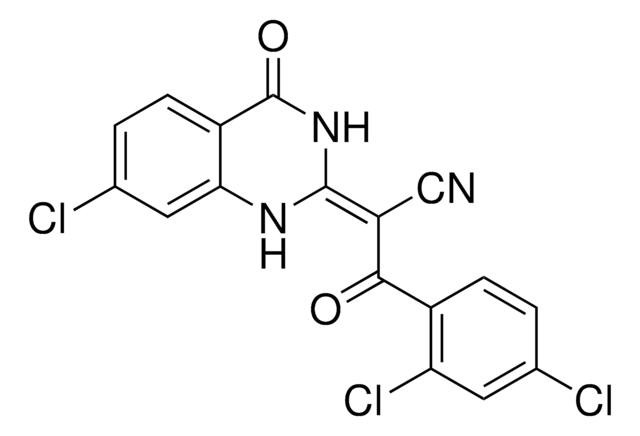Key Documents
H4541
HPI-4
≥98% (HPLC)
Synonim(y):
2,4-Dichloro-a-(3,4-dihydro-4-oxo-2(1H)-quinazolinylidene)-β-oxo-benzenepropanenitrile, Ciliobrevin A, Hedgehog Pathway Inhibitor 4
About This Item
Polecane produkty
Poziom jakości
Próba
≥98% (HPLC)
Postać
powder
kolor
off-white, off-white to orange
rozpuszczalność
DMSO: 10 mg/mL, clear
temp. przechowywania
2-8°C
ciąg SMILES
Clc1ccc(c(Cl)c1)C(=O)\C(C#N)=C2\NC(=O)c3ccccc3N2
InChI
1S/C17H9Cl2N3O2/c18-9-5-6-10(13(19)7-9)15(23)12(8-20)16-21-14-4-2-1-3-11(14)17(24)22-16/h1-7,21H,(H,22,24)/b16-12+
Klucz InChI
SESYPWCSIZUIAS-FOWTUZBSSA-N
Zastosowanie
Działania biochem./fizjol.
Hasło ostrzegawcze
Warning
Zwroty wskazujące rodzaj zagrożenia
Zwroty wskazujące środki ostrożności
Klasyfikacja zagrożeń
Acute Tox. 4 Oral - Aquatic Acute 1 - Aquatic Chronic 1
Kod klasy składowania
11 - Combustible Solids
Klasa zagrożenia wodnego (WGK)
WGK 3
Temperatura zapłonu (°F)
Not applicable
Temperatura zapłonu (°C)
Not applicable
Certyfikaty analizy (CoA)
Poszukaj Certyfikaty analizy (CoA), wpisując numer partii/serii produktów. Numery serii i partii można znaleźć na etykiecie produktu po słowach „seria” lub „partia”.
Masz już ten produkt?
Dokumenty związane z niedawno zakupionymi produktami zostały zamieszczone w Bibliotece dokumentów.
Klienci oglądali również te produkty
Nasz zespół naukowców ma doświadczenie we wszystkich obszarach badań, w tym w naukach przyrodniczych, materiałoznawstwie, syntezie chemicznej, chromatografii, analityce i wielu innych dziedzinach.
Skontaktuj się z zespołem ds. pomocy technicznej












